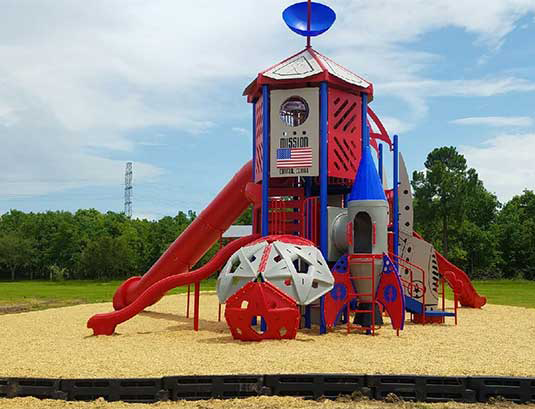Playground Design Trends To Watch For in 2020

Progressive playground design has always focused on sustainable and inclusive ways to encourage imagination and play, increase physical strength and fitness, and strengthen a sense of belonging and community. And just to keep things fresh, playground architects and designers have been finding more and more ways to add adventure, color, creativity, and expanded sensory experiences to make our children’s outdoor play spaces even more engaging.
So what’s on the horizon for 2020 for playground design?
1. Inclusivity. Playground design in 2020 and beyond will place an even greater emphasis on one of the foundations of modern play space design: inclusivity. The newest playground concepts provide opportunities for differently-abled children to play and discover. All of the equipment is designed to challenge and engage visitors equally; there are no separate sections for “special needs” or “handicapped” children and adults .
2. Technology. Modern playground embrace technology, allowing connections among users that were neither possible nor cost-effective before now. For example, the following technological features will be incorporated into play spaces:
- Beacons. Simple Bluetooth devices mounted throughout the park, beacons provide navigational assistance and multi-media experiences for individuals and groups using the park. They can even help users keep track of where they parked.
- Geofences. This RFID or GPS technology defines the park by certain areas. It senses when visitors enter the area and communicates appropriately via an opt-in mobile app.
- Drones. Also known as Unmanned Aerial Vehicles (UAVs), drones are being used in playgrounds for monitoring and public safety.
3. Sustainability. Look for more eco-friendly materials in surface options and playground equipment in 2020 High-density Polyethylene, or HDPE, is manufactured from milk jugs and other household plastic which is shredded, melted and molded into components for playground equipment. Wooden playground equipment has always been a favorite, but designers will be careful to call for playground equipment that has been certified as having been built from sustainably forested wood..Expanded recycling programs will also be an integral part of keeping playgrounds well-maintained and litter-free.
4. Themes. Picture playground equipment made to look like a space capsule, underwater shipwreck, or medieval castle! These themed structures accomplish the traditional goals of outdoor play spaces while offering expanded opportunities for creative and imaginative play.
5. Musical Features. Imagine children’s (and parents’) delight to hear music incorporated into playground design! Developers are installing chimes, bells, drums– even small keyboards– into playgrounds to stimulate motor and cognitive development in children and provide spontaneous outlets for self-expression. Since music is non-verbal, it offers a communication option for those with speech difficulties.
Inclusive design, technology, sustainability, themes, and musical features are just the tip of the iceberg for the next decade of playground design. Fitness structures and sensory areas will continue to be popular. On the leading edge, developers are beginning to experiment with things like trampoline parks, bouncing spaces, more unique climbing facilities, dog parks, and multi-sports bubbles. A few designers are beginning to play with incorporating libraries, health services, and after school care within playground structures.
These are just a few of the innovations currently on the radar for 2020. Playground designers and developers will continue to learn how to combine and create the most engaging spaces from the best teachers there are: children!




